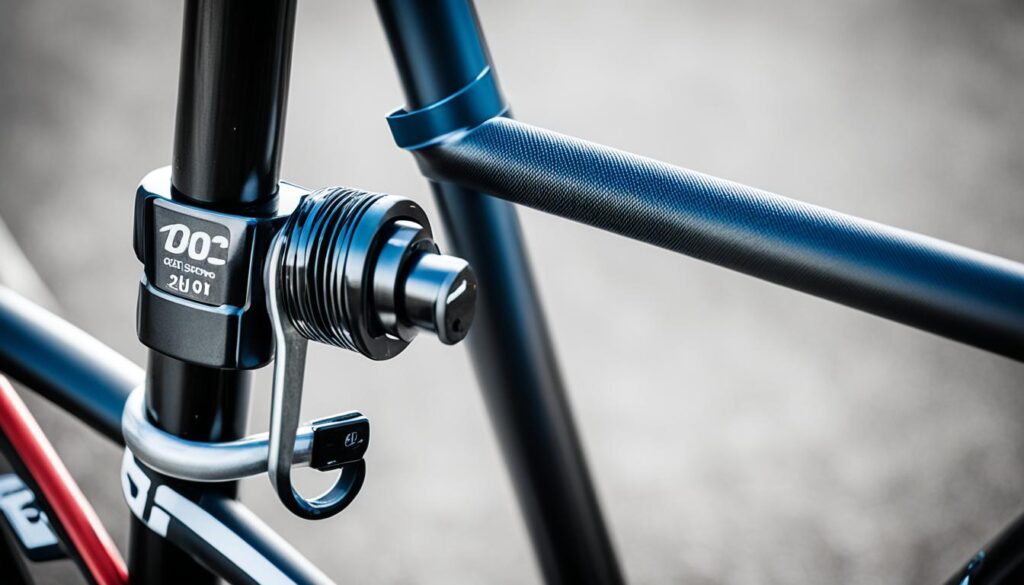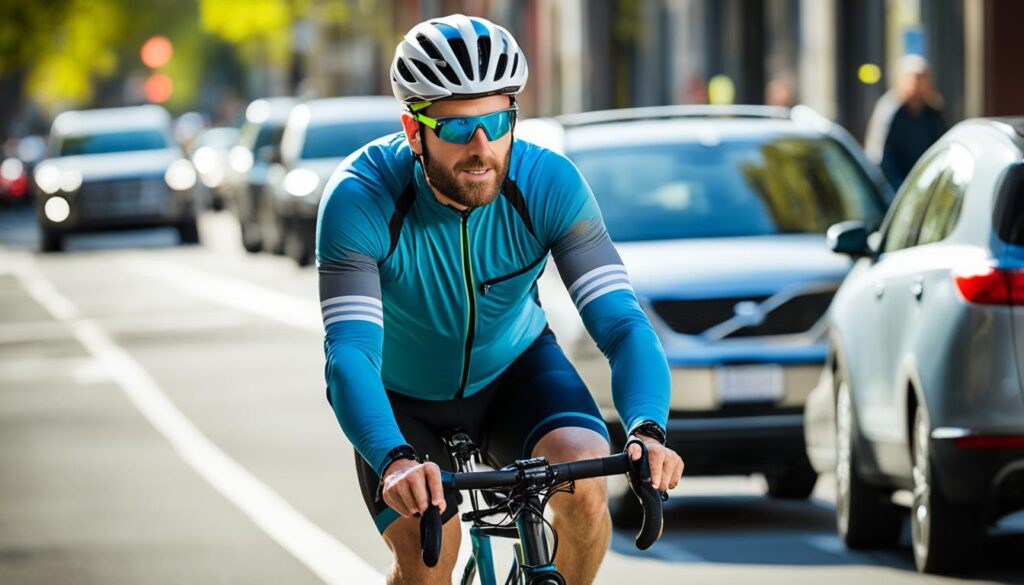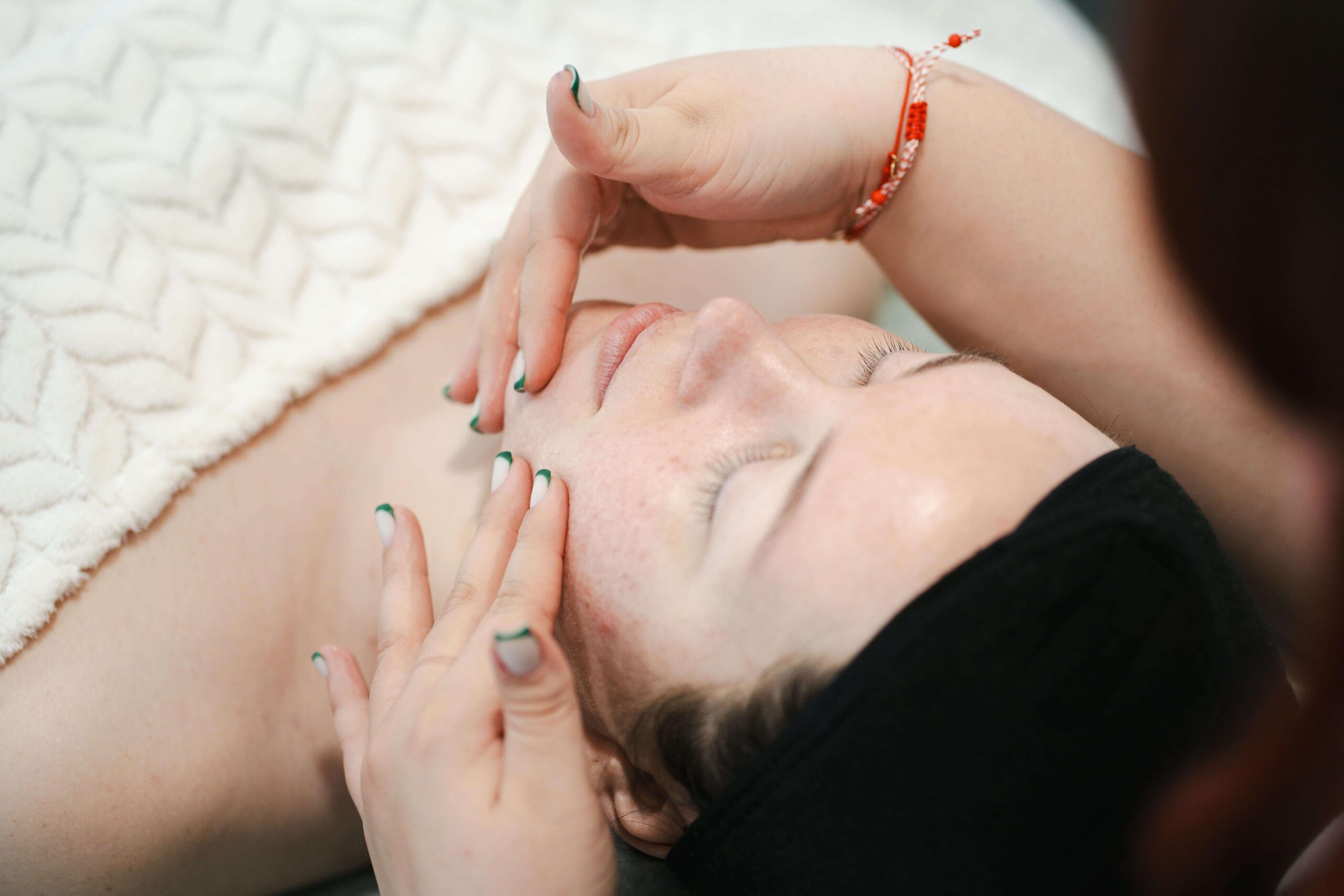Choosing to cycle to work is a great way to be eco-friendly and healthy. But, it’s important to plan and prepare well. This guide gives you key tips to make your city rides better. Whether you’re experienced or new to biking to work, you’ll learn how to stay safe, efficient, and happy.
Table of Contents
ToggleKey Takeaways
- Equip your bike with essential safety gear for a secure commute
- Perform pre-ride maintenance checks to ensure your bicycle is road-ready
- Employ defensive riding techniques to navigate city streets with confidence
- Increase your visibility and alertness to stay safe in all weather conditions
- Plan bike-friendly routes to optimize your commute and avoid hazards
Preparing for Your Commute
Getting ready for your bike commute means having the right commuter cycling gear and making sure your bike works well. This guide will help you with the cycling equipment and bike maintenance checklist you need for a smooth ride.
Essential Gear for Safe Cycling
When you’re getting ready for your cycling commute, safety comes first. You’ll need:
- A properly fitted bicycle helmet to protect your head
- Lights for front and back visibility in the dark
- Reflective gear to make you more visible
- A bike lock to keep your bike safe
- A bike pump and tire repair kit for emergencies
Pre-Ride Bicycle Maintenance Checklist
Before you start your ride, make sure your bike is ready. Here’s what to check:
- Check and inflate the tire pressure
- Look at the brakes to make sure they work and aren’t worn out
- Make sure the chain is well-lubricated
- Test the lights and reflectors to ensure they’re on
- Adjust the seat and handlebars for your comfort
Preparing your bike and gear properly makes your cycling commute safe and fun. With the right essential cycling equipment and a good pre-ride inspection, you’ll feel confident on your daily bike ride.
Navigating City Streets
Riding a bike in the city can feel overwhelming, but with the right skills, you can ride safely and with confidence. The key is to use defensive cycling to stay safe. This means being super aware of what’s happening around you.
Defensive Riding Techniques
Defensive cycling means being proactive and always watching what’s happening on the road. Always check the road ahead, behind, and to the sides for dangers like cars opening doors or pedestrians stepping out. Think ahead about what drivers might do and be ready to move fast to avoid accidents.
It’s important to position yourself well in the lane for safety. Stay in the middle of the lane to be more visible and stop cars from passing too closely. When you’re going through intersections or turns, take the lane to make sure drivers see you.
Learning these defensive cycling techniques will make you safer and more confident on the road. Being a defensive cyclist is essential for enjoying city cycling.
“The most important thing is to be visible and predictable. Ride confidently, make eye contact with drivers, and always be prepared to take evasive action.”
– Jane Doe, Cycling Safety Instructor
| Defensive Cycling Technique | Description |
|---|---|
| Scanning for Hazards | Always look ahead, behind, and to the sides for dangers like car doors, merging cars, and pedestrians. |
| Positioning in the Lane | Ride in the middle of the lane to be more visible and stop cars from passing too close. |
| Anticipating Driver Behavior | Guess what drivers might do and be ready to move fast to avoid accidents. |
| Assertive Lane Taking | Take the whole lane at intersections and turns to make sure drivers see you. |
By using these defensive riding tips, you can feel more confident and safe while biking in the city. Remember, being a defensive cyclist is key to enjoying city cycling.
Cycling Tips for Commuters
Cycling to work is great for staying fit, saving money, and cutting down on pollution. But, it comes with its own set of challenges. We’ve put together some key cycling tips for commuters. These tips cover everything from finding the best routes to keeping your bike safe.
- Plan your route well. Look for bike-friendly roads, trails, and lanes to dodge busy areas and lower your risk of accidents. Apps like Google Maps can help you find the safest and quickest bike commuting advice.
- Do a quick check before you ride. Make sure your tires are full, brakes work, and everything is in good shape. Keeping your bike in top condition is important for safe commuter cycling best practices.
- Get some urban cycling hacks, like a bright front light, rear light, and reflective gear. These will make you more visible and safer, especially when riding early in the morning or at night.
- Learn how to ride defensively. Stay alert, watch out for dangers, and be ready to act fast. Knowing what might happen and being ready to react is key to staying safe.
- Lock your bike up right. Use a strong lock and think about joining a bike theft prevention program. Locking your bike in a busy, well-lit spot can also keep thieves away.
Follow these cycling tips for commuters to make your bike ride to work safer, more efficient, and fun. Being ready, alert, and proactive is the secret to successful bike commuting advice.
“Cycling is the most energy-efficient human transport mode for short to medium distances.” – World Health Organization
Staying Visible and Alert
Cycling in cities means you need to be extra visible and alert to stay safe. The right gear and lights can really help you be seen by drivers and others on the road. This is key for a safe commute.
Reflective Gear and Lighting Options
Reflective gear is a must for cyclists who want to be more visible. Items like reflective ankle straps, vests, and tape for your bike help you stand out in the dark. Also, bike lights for commuting are crucial for riding in the early morning or evening. Using both front and rear lights makes sure you’re seen from all sides.
| Reflective Cycling Gear | Commuter Bike Safety Equipment |
|---|---|
|
|
Being visible and alert is key to staying safe as a cyclist. With the right reflective cycling gear and bike lights for commuting, you can safely move through the city streets.
Dealing with Inclement Weather
Cycling in rain, snow, or bad weather can be tough but rewarding. With the right gear and techniques, you can keep enjoying your bike commute. This way, you can handle whatever the weather brings.
Cycling in the Rain
When it rains, you need waterproof and water-resistant gear. Get a good rain jacket, pants, and shoe covers to stay dry and comfy. Also, add fenders to your bike to keep water off the road. And, think about using tires that can resist punctures for better grip.
Biking in the Snow
Cycling in snow needs extra care and prep. Put studded or snow tires on your bike for better grip on ice. Wear warm, breathable clothes and don’t forget gloves, a balaclava, and shoe covers to keep your hands and feet warm.
Dealing with Wind and Gusts
Strong winds can make biking tough. Wear a jacket that blocks wind and use a low-profile helmet to reduce wind impact. Choose routes with wind breaks like buildings or trees. Adjust your speed and pedaling to keep your bike under control.
| Weather Condition | Recommended Gear |
|---|---|
| Rain | Waterproof jacket, pants, shoe covers, and fenders |
| Snow | Studded tires, warm layers, gloves, balaclava, shoe covers |
| Wind | Wind-resistant jacket, low-profile helmet |
With the right weather-resistant cycling gear and smart riding tips, you can handle cycling in rain, biking in snow, and other bad weather. A bit of prep and flexibility lets you keep enjoying bike commuting, no matter what the weather does.
Bike-Friendly Route Planning
Choosing the right bike route can greatly improve your commute. It’s key to use bike lanes and trails for safety and efficiency. This makes your ride better.
Utilizing Bike Lanes and Trails
Using bike lanes and trails is a great way to make your commute safer and more fun. These paths keep you away from cars, lowering the chance of accidents. They make riding a bike more enjoyable.
- Look for bike lanes on main streets and roads in your area. They give cyclists their own space.
- Try off-street bike trails and greenways for a ride without cars.
- Use local maps and city resources to find the best bike commuter routes with these paths.
By using bike lanes and trails, you can find the best commute by bike. This reduces stress and makes your cycling more fun.
“Bike-friendly route planning is the key to a safe and efficient cycling commute. Take advantage of dedicated infrastructure to maximize your time on the road.”
Commuting with Cargo
When you cycle to work, you might need to carry things like laptops, documents, or groceries. Luckily, there are many ways to carry your stuff while biking. You can choose from backpacks, panniers, or bike trailers for commuting. The right gear can make your ride more efficient and comfy.
Backpack, Panniers, or Trailers?
A backpack is a popular choice for carrying stuff while biking. It’s easy to use and doesn’t let your hands go free. But, it might get tiring and uncomfortable on long rides. Panniers attach to your bike’s rack, spreading the weight out and easing back strain. For big loads, bike trailers for commuting are great. They give you lots of space and let you ride without being weighed down.
When picking between backpacks vs. panniers, think about how much and what you’re carrying, your commute length, and what you prefer. If you often carry big or heavy things, a bike trailer for commuting could be best.
The best bike commuter gear for carrying stuff depends on what you need and how your bike is set up. Try out different options to see what works best for your daily bike trip.
Locking and Securing Your Bike
Keeping your bike safe is key when you’re commuting, as bike theft happens a lot in cities. A good bike lock and the right way to lock it can stop thieves and keep your bike safe. This is true whether you’re at work or out doing errands.
Don’t use cheap locks or lock your bike the wrong way. It makes it too easy for thieves. Instead, go for a U-lock or a chain lock from a trusted brand. These locks are tough and won’t let thieves get your bike.
Lock your bike in a safe spot, like a bike rack or a strong post. Stay away from “sucker poles” that thieves can easily cut or take off. Make sure your lock is hard to reach and won’t fit over the handlebars or frame. Using more heavy-duty locks in risky places can help stop theft and add extra safety.
| Lock Type | Recommended for | Approximate Cost |
|---|---|---|
| U-Lock | Commuting, Short-Term Parking | $40 – $80 |
| Chain Lock | Long-Term Parking, High-Risk Areas | $60 – $150 |
| Cable Lock | Supplementary Lock, Additional Security | $10 – $30 |
No lock can stop a determined thief, but making it hard to steal your bike lowers the risk. By choosing quality bike locks and locking your bike right, you can ride to work or run errands without worry.

Cycling Etiquette and Laws
As a responsible bike commuter, it’s key to know the cycling etiquette and laws. These rules help ensure a safe and peaceful sharing of the streets with others. By following them, you can make sure everyone gets along on the road.
Sharing the Road Responsibly
Cycling etiquette and laws aim to keep the roads safe and respectful for everyone. Here are some important tips for cyclists:
- Obey all traffic signals and signs, just as you would when driving a car.
- Ride predictably and in a straight line, avoiding sudden moves that could surprise other drivers.
- Signal your turns and lane changes well in advance to communicate your intentions.
- Be aware of your surroundings and yield the right-of-way to pedestrians and vehicles when needed.
- Respect bike lanes and trails, and use them when possible to keep cyclists away from other traffic.
- Be kind to other cyclists, pedestrians, and motorists, and avoid any actions that could be seen as aggressive or dangerous.
By sticking to these basic rules, you help make cycling safer and more fun for everyone.
“Cycling is not only a mode of transportation, but also a way of life. By embracing cycling etiquette and laws, we can all contribute to making our streets safer and more accessible for everyone.”
Responsible bike sharing and commuting means we all need to respect the road rules. By staying informed and careful, you can help build a positive cycling culture for our community.
Nutrition and Hydration for Cyclists
Proper nutrition for cyclists and staying hydrated are key for good cycling performance and recovery. It’s important to know what you need based on your fitness level, age, and how hard you train. This knowledge helps you fuel up right for your bike commute, keeping you energized and feeling great all day.
Cycling isn’t just about looking good. It’s about fueling your body for performance. You should focus on foods that give you long-lasting energy and help your muscles recover. From snacks before you ride to food after, getting your hydration right is crucial for a better cycling experience.
Basic Nutrition Practices for Cyclists
- Plan meals that match your ride’s length, making sure they have the right mix of carbs, proteins, and healthy fats.
- Drink water before, during, and after your ride. For longer rides, use sports drinks that have electrolytes.
- Eat snacks before and after riding that give you a quick energy boost and help your muscles recover.
- Avoid running out of energy or getting glycogen depletion by packing easy-to-digest snacks for your bike trips.
Adding these nutrition and hydration tips to your cycling routine will make your commute better and more enjoyable.
“Proper fueling and hydration are the foundation of cycling performance and recovery. Don’t neglect this critical aspect of your training and commuting.”
Bike-Friendly Workplaces
More people are choosing to bike to work, so companies are starting to offer bike-friendly options. Bike-friendly workplaces and commuter-friendly offices now have special facilities for cyclists. These include things like bike racks, showers, and locker rooms.
Facilities and Amenities for Commuters
A big part of being bike-friendly is having safe bike storage at work. Companies might have indoor racks, lockers, or even a special room for bikes. This keeps bikes safe all day.
Some companies also offer showers and locker rooms for cyclists. This lets workers clean up and change before starting their day.
Some companies go even further. They have bike repair stations with tools and air pumps. This helps cyclists keep their bikes in good shape.
Having these commuter-friendly things at work encourages more people to bike to work. It shows that companies care about sustainable transport. By doing this, companies can create a bike-friendly culture.
Health Benefits of Cycling Commutes
Choosing to bike to work has many health perks, not just for the planet. It boosts your heart health, energy, and cuts stress.
One big plus of biking to work is it makes you fitter. It works out your heart, lungs, and muscles. This means you get physical and mental advantages of cycling to work. Plus, it lowers the risk of serious illnesses like heart disease and cancer.
| Health Benefit | Description |
|---|---|
| Cardiovascular Health | Cycling is a great way to exercise your heart and improve blood flow. It helps prevent heart disease and high blood pressure. |
| Weight Management | Biking to work helps keep your weight in check or helps you lose pounds. It burns a lot of calories. |
| Stress Reduction | Being active and spending time outside on your bike commute can make you feel less stressed. It also boosts your mental health. |
Besides physical perks, biking to work is good for your mind too. It lowers stress, makes you happier, and sharpens your mind. The exercise and fresh air during your commute lift your mood and overall well-being.
“Cycling to work is one of the easiest ways to incorporate physical activity into your daily routine and reap the health benefits of bike commuting.”
If you want to boost your heart health, manage your weight, or reduce stress, cycling to work is a great choice. It’s easy, green, and good for you. By enjoying these health benefits of bike commuting, you can live a healthier, more active life.

Building Cycling Endurance
Starting a regular bike commute can be rewarding but challenging, especially for beginners. Whether you’re new to cycling or have been riding for years, building your endurance is key. It makes your daily ride easier and more fun.
Training Tips for New Riders
Building your cycling endurance takes time, but you can get better with the right steps. Here are some tips to help you start:
- Start with short rides and slowly increase your time and distance. Add 5-10 minutes to your commute each week to build up your endurance.
- Use interval training to mix up your pace. Alternate between hard pedaling and easy recovery periods to boost your endurance.
- Do strength exercises like squats, lunges, and calf raises to strengthen your legs. This helps with cycling endurance training.
- Eat a balanced diet full of carbs, proteins, and healthy fats to support your commuter cycling workouts.
- Rest and recover to avoid burnout and injury. Too much training can slow you down.
Being consistent is important for tips for new bike commuters. Stick to a regular routine, and you’ll get better at tackling your daily commute with ease and fun.
| Tip | Description |
|---|---|
| Start Small | Gradually increase your riding time and distance to build endurance. |
| Interval Training | Alternate intense pedaling with recovery periods to challenge your body. |
| Strength Training | Incorporate exercises that target your leg muscles to build power. |
| Nutrition and Hydration | Fuel your body with a balanced diet and stay hydrated to support your workouts. |
| Rest and Recovery | Listen to your body and allow for rest days to prevent burnout and injury. |
“Consistency is the key to building endurance. Stick to a regular cycling routine, and you’ll gradually see improvement in your performance and enjoyment of your daily commute.”
Conclusion
This guide has given you lots of tips to make biking to work safe, efficient, and fun. By using what you’ve learned, you can ride through the city with ease. You’ll be able to stay safe, carry your stuff, and enjoy the health perks of biking.
Getting ready and staying positive can make your bike ride to work something to look forward to. You’ve learned how to ride safely, find bike-friendly paths, and use bike lanes. This guide has given you the key skills to make your commute better.
As you start biking to work, remember the tips and advice from this article. Using these tips will help you ride safely and efficiently. It will also help make the city a better place for everyone. Enjoy the freedom and health that come with biking to work!
FAQ
What are the best nutrition tips for endurance athletes?
Endurance athletes need special nutrition to help them train and perform well. Important tips include:
– Eating complex carbs for long-lasting energy
– Drinking electrolyte-rich drinks to stay hydrated
– Eating protein and carbs after workouts to refuel
– Adding nutrient-rich whole foods like fruits, veggies, and lean proteins to your diet
– Thinking about supplements like BCAAs, creatine, or beetroot juice for extra benefits
How can I properly fuel for long-distance events?
To fuel for endurance events, follow these steps:
– Load up on carbs before the event to fill glycogen stores
– Use easy-to-digest carbs like gels, chews, or sports drinks during the event to keep energy up
– Replenish lost electrolytes with drinks or tablets
– Bring snacks like trail mix, banana bread, or protein bars for before and after the event
What are some key hydration strategies for endurance athletes?
Staying hydrated is key for endurance athletes. Here are some tips:
– Drink water or electrolyte drinks regularly during training and events
– Check your urine color to see if you’re hydrated
– Figure out how much sweat you lose to know how much to drink
– Try different products and formulas to find what works best for you
How can plant-based athletes optimize their nutrition?
Plant-based athletes can get all they need with a good diet plan. Focus on:
– Eating nutrient-rich whole foods like beans, grains, greens, and nuts
– Getting enough protein from tofu, tempeh, seitan, or plant-based powders
– Taking supplements for B12, iron, and omega-3s if needed
– Plan meals and snacks to support your training and recovery
What should I eat before and after a workout?
Before working out, eat meals with carbs that are easy to digest and some protein:
– 1-2 hours before: Oatmeal with fruit, a banana with nut butter, or whole grain toast with avocado
– 30 minutes before: A sports drink, energy gel, or fruit
After working out, focus on carbs and protein to refuel and help muscles recover:
– Within 30 minutes: A protein shake, chocolate milk, or yogurt with granola
– 1-2 hours after: A big meal with lean protein, complex carbs, and veggies









